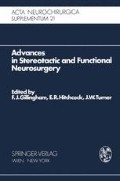Abstract
While the semimalignant gliomas of the diencephalon, mesencephalon and cerebral trunk are inoperable by conventional neurosurgical methods, resistant to treatment with external techniques of irradiation2, 3, 4 and can be freed of internal pressure only through fluid-drainage operations, they have long been the targets of stereotactic operational treatment13 principally using the method of implanting radioactive gold-198 and yttrium-90 (Talairach and Szikla14, Hankinson1, and others). We ourselves (Mundinger and Riechert) began using such implantations in 195412. Then starting in 1966 Mundinger undertook to implant iridium-192, with its half-live of 74 days, into most of the astroblastomas, oligoblastomas and spongioblastomas which we treated10. Prior to this we had gathered over 10 years of encouraging experience with iridium-192, using it for irradiation of semimalignant trabecular gliomas, gliomas of the hemisphere and pituitary adenomas6, 7, 8, 9. Since this form of protracted long-term irradiation5 entails a relatively slow dosage accumulation over a period of 7 months, there is a gradual build-up of scar tissue and shrinkage of the tumour. Whereas the short-lived radioisotopes mentioned have a necrotic effect, the iridium-192 irradiation causes devitalisation and thus protects to a great extent the intact intermediate and surrounding neuronal structures and permits compensating processes to develop. This explains why, clinically as well, no reaction to irradiation is noted. The initially low sensitivity of these tumour cells towards radioactivity increases as a result of the long-term accumulation of irridiation doses, and thus they are more apt to be lethally affected by radioactivity than is the surrounding tissue. Moreover, continual emission of the doses ensures with great probability that the tumour cells in the periphery which have a premitotic pause will be lethally hit rather than the normal cells. This gives us an idea of the basically different radiobiologic mechanisms which are most advantageous for tumour localization. But it also makes it apparent that tumours showing malignant stigmata are unsuited for this type of long-term irradiation.
Supported by a Special Research Programme „Gehirnforschung und Sinnesphysiologie (SFB 70, IIId)“ of the Deutsche Forschungsgemeinschaft.
Access this chapter
Tax calculation will be finalised at checkout
Purchases are for personal use only
Preview
Unable to display preview. Download preview PDF.
References
Hankinson, J. (1961), Therapeutic isotopes. Excerpta medica (Amsterdam) Int. Congr. Series 36. II. Int. Congr. Neurochir. Washington.
Lindgren, M. (1958), On tolerance of brain tissue and sensitivity of brain tumours to irradiation. Acta radiol. (Stockholm) Suppl. 170.
Lindgren, M. (1965), Die Strahlenbehandlung der Hirntumoren. Dtsch. Röntgenkongr. 1964, Teil B. Strahlenbehandlung und -biologie, S. 220–230. München und Berlin: Urban und Schwarzenberg.
Löhr, H.-H., Vieten, H. (1967), Die Strahlenbehandlung raumbeengender intracranieller Prozesse. In: Handbuch der Neurochirurgie, Bd. IV, S. 421–566. Berlin-Heidelberg-New York: Springer.
Mundinger, F. (1958), Beitrag zur Dosimetrie und Applikation von Radio-Tantal (Ta182) zur Langzeitbestrahlung von Hirngeschwülsten. Fortschr. Röntgenstr. 89, 86–91.
Mundinger, F. (1966), Treatment of brain tumors with radioisotopes; in Krayenhühl, Maspes and Sweet: Progress of neurological surgery, Vol. 1, pp. 101–145. Basel/New York: Karger.
Mundinger, F. (1969), Techniques and indications for the interstitial irradiation of brain and pituitary tumours with radionuclides. Kerntechnik, Isotopentechnik und Chemie 11, 333–345.
Mundinger, F. (1969), Die intraselläre protrahierte Langzeitbestrahlung von Hypophysenadenomen mittels stereotaktischer Implantation von Iridium-192. Acta radiol. (Stockholm) 8, 55–62.
Mundinger, F. (1970), The treatment of brain tumors with interstitially applied radioactive isotopes. In: Yen Wang and Paoletti Monograph: Radionuclide Applications in Neurology and Neurosurgery, pp. 199–265. Springfield, Ill.: Ch. C Thomas.
Mundinger, F., Metzel, E. (1968), Erfahrungen mit der lokalen Strahlenbehandlung inoperabler Zwischenhirn-und Basalganglientumoren mit der stereotaktischen Permanent-Implantation von Iridium-192. Arch. Psychiat. Nervenkr. 212, 70–90.
Mundinger, F. (1970), Interstitial radioisotope therapy of intractable dien- cephalic tumors by the stereotaxic permanent implantation of Iridium-192, Including Biotic Control. 4th Symp. Int. Soc. Res. Stereoencephalotomy, New York 1969. Confin. Neurol. 32, 195–202.
Mundinger, F., Riechert, T. (1967), Hypophysentumoren-Hypophysektomie. Stuttgart: Thieme.
Riechert, T., Mundinger, F. (1959), Stereotaktische Geräte. In Schalten-brand und Bailey: Einführung in die stereotaktischen Operationen mit einem Atlas des menschlichen Gehirns. Stuttgart: Thieme.
Talairach, J., Bonis, A., Szikla, G., Schaub, G., Bancaud, J., Covello, L., Bordas-Ferrer, M. (1970), Stereotaxic implantation of radioactive isotopes in functional pituitary surgery: technique and results; in Yen Wang and Paoletti Monograph: Radionuclide Applications in Neurology and Neurosurgery, pp. 267–299. Springfield, Ill.: Ch. C Thomas.
Vieten, H., Löhr, H.-H. (1965), Probleme und Möglichkeiten der Strahlenbehandlung von Hirntumoren. Nervenarzt 36, 429–437.
Author information
Authors and Affiliations
Editor information
Editors and Affiliations
Rights and permissions
Copyright information
© 1974 Springer-Verlag
About this paper
Cite this paper
Mundinger, F., Hoefer, T. (1974). Protracted Long-Term Irradiation of Inoperable Midbrain Tumours by Stereotactic Curie-Therapy using Iridium-192. In: Gillingham, F.J., Hitchcock, E.R., Turner, J.W. (eds) Advances in Stereotactic and Functional Neurosurgery. Acta Neurochirurgica, vol 21. Springer, Vienna. https://doi.org/10.1007/978-3-7091-8355-7_13
Download citation
DOI: https://doi.org/10.1007/978-3-7091-8355-7_13
Publisher Name: Springer, Vienna
Print ISBN: 978-3-211-81212-9
Online ISBN: 978-3-7091-8355-7
eBook Packages: Springer Book Archive

